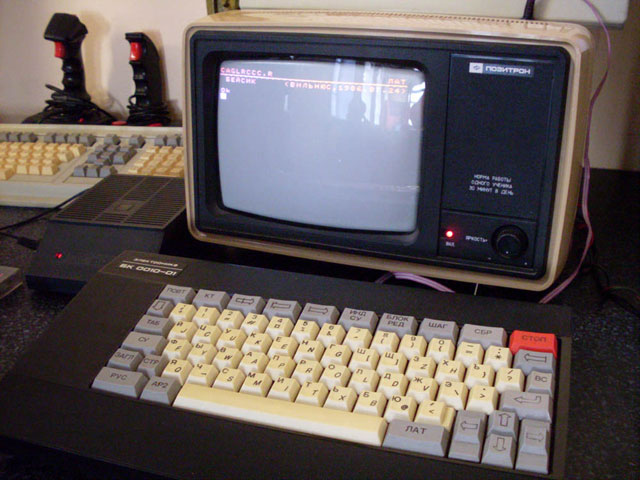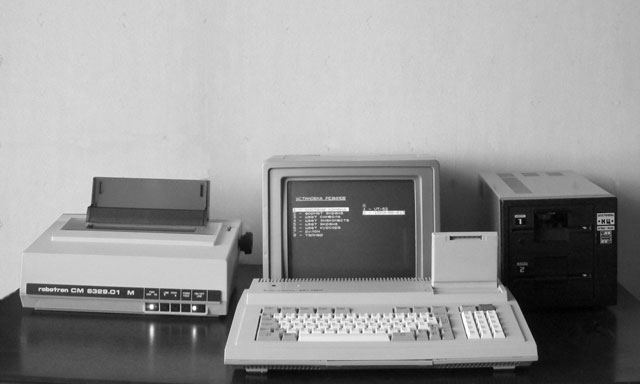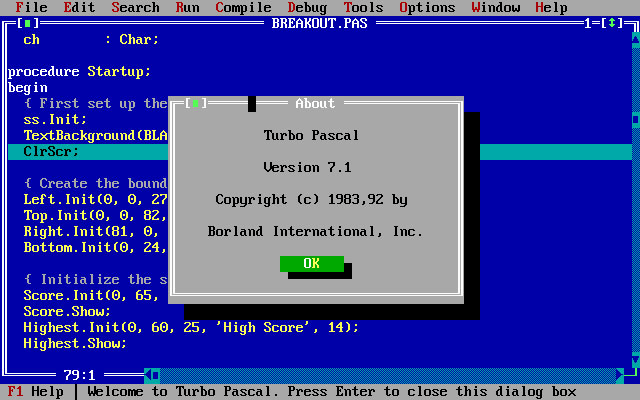The evolution of the school computer. Part One, Historical

In the life of every child, the first of September always comes, the date separating freemen of varying degrees of carelessness from student everyday life. At school, the child will have to learn a lot of subjects, but in this blog, which is logical, we are most interested in computer science. Let us on the occasion of the day of knowledge, albeit with a slight delay, recall the educational computers of our school childhood, and then, in the next post, we will talk about today's day - which devices you can see in the class now and what they are talking about.
1. The late Soviet era (1985-1991)
The program to reform Soviet education in 1984 provided for, among other things, the introduction in schools of a new subject - “Fundamentals of computer science and computer technology” (JIHT). The implementation of the program began in 1985, at the same time dozens of research institutions, including biological and chemical, began to design personal computers (although they did not yet know this combination of words) for the needs of education. As a result, over the years, many PC models have been created; some subset of them managed to be put into mass production.
Personal computer BK-0010
The technological gap in cybernetics between the two sides of the “iron curtain” at that time was already significant, so all models of “socialist PCs” were to some extent (usually significant) replicas of foreign ones. In the tablet below, I tried to draw a general picture of Soviet computer engineering using the example of its most famous representatives (PCs produced by social countries that were supplied to the USSR were also added here). If you notice any inaccuracies in it, please write in the commentary or PM.
| Standard / Original | CPU | Models |
|---|---|---|
| DEC PDP-11 | KM1801BM1 / 2 | DVK-1 |
| DVK-2 | ||
| BK-0010 | ||
| MS 0511 Electronics | ||
| Intel i8080 | KR580VM80A | Corvette PK8010 / PK8020 |
| Microsha | ||
| Irisha | ||
| Zilog Z80 | T34BM1 | Companion |
| Quantum BC MS0530 | ||
| U880 | Robotron KC 85 / KC 87 (GDR) | |
| Intel i8086 / 8088 | KM1810BM86 | Assistant 128 |
| EU-1840, EU-1841 | ||
| KM1810BM88 | Search | |
| MS 1502 Electronics | ||
| 6502 | MOS Technology 6502 | Agate |
| CM630 | Pravets 8 (Bulgaria) |
')

Workplace teacher KUVT "UK-NC"
In addition to domestic products, in the classes of the most advanced schools one could meet directly their foreign originals. First of all, this is the Yamaha KUVT based on Japanese MSX Yamaha YIS-503/805 computers. There were also Korean MSX Daewoo, distinguished by the absence of Russian letters on the keyboard and ubiquitous hieroglyphization. Here it is impossible not to recall the legendary Sinclair ZX Spectrum - for many it was he or his clones that became not only the first training, but also the first home computer. Well and, besides, there were a number of imported PCs on the Intel platform (for example, IBM PC / XT) - true, then there were relatively few of them in the total mass.

KUVT "Yamaha", student PC
What were the PC of the first generation (for the USSR)? The processor is from 1 to 10 MHz, the standard amount of RAM - from 32 to 128 KB. As the information carrier - a tape cassette or a diskette 5 (8) inches. Monochrome black and white or black and green monitor. If you're lucky, the dot matrix printer is in place of the teacher. From the standpoint of today's gigahertz, such characteristics are poorly absorbed, but it is definitely better than a piece of paper or a programmable calculator, and it was from them that computer science began in many schools. By the way, KUVT UK-NC reached our school in Nizhny Novgorod only in 1993, and the JIHT itself reached a year earlier.
Despite the primitive elementary base even for that time, Soviet PCs often broke down, and the warranty repair system was slow, they said there were not enough spare parts. I remember that out of 13 student jobs, we usually worked 10-11. Nevertheless, it was a revelation that determined for many of us habrayuzer, the direction of movement in life. The first computer science programs were rather abstract: theoretical issues were studied (number systems, discrete mathematics), the construction of algorithms and flowcharts, abstract instruction systems, etc. Here, for example, a scan from the stern Soviet textbook of 1990 - everything is serious, no "right-click":

They didn’t get to programming languages right away, usually the case was limited to BASIC, Pascal was also given in schools with in-depth studies.
2. Early Russian era (1991-2000)
By the time of the destruction of the USSR, there was a computer class in almost every school in major cities; non-enrolled students underwent computer practice in training and production facilities (CPC). So, at least, it was in our region. How was it with you? Tell that!
Time in the classroom informatics flew by. Game Laser Squad on PC ZX Spectrum
The zoo of incompatible computer classrooms made it difficult to exchange experiences and software between schools, and yet it took place in full growth. Most appreciated, of course, were toys - they existed for any, even the most primitive PCs. For a good game, it was not a sin to run to a school in another district of the city, it was recorded on several floppy disks at once, as they often failed. In the price were also programs of automatic testing of students' knowledge, often self-written, and software for teaching other subjects of the school curriculum (to demonstrate to admired colleagues). The same period was the heyday of computer science literature: there were about a dozen different journals, both general, such as Computer Science and Education, and dedicated to specific platforms. About the same was computer science textbooks, which created a certain chaos and as a result, many teachers did not use any at all.

IBM PS / 2 - one of the first mass x86 in the country of the Soviets
The Soviet KUVT fleet decayed over time, but was exploited to a victorious end; despite the growing difficulties with the repair of old equipment, the lack of funds for the purchase of new forced to dodge. Including due to school demand, cooperatives for the repair of computer equipment appeared, some of which subsequently grew into large firms. This situation continued until the global computerization of the beginning of this century; there is verified information that even in 2001 a number of Soviet PCs still worked in schools.
In parallel with the extinction of the Soviet PCs, new schools were unorganized purchased unorganized, almost 100% on the x86 platform, which by then had become a world standard. The implementation of 286, and then 386 with the standard DOS OS (albeit in different dialects) made it possible to begin standardization of programs and development tools. The first topics for PC users describing a specific software appeared in the training programs; the first, to my knowledge, was given this honor by the famous “Norton Windows” (Norton Commander). The people's fear of programming has been greatly reduced after the appearance of window development tools in classes (hello, Turbo Pascal!).

The same turbo pascal
The next page of the story is connected with Intel Pentium and Windows 95. Easy network configuration in the new Windows led to the mass appearance of computer classes in their modern form - a group of computers connected to a local network. The connectivity of computers is not only a means of transmitting viruses (of which there were a little more at that time), but also the ability to remotely monitor a student and transmit materials and programs over the network. On the new methods of working in computer classrooms, we will continue the conversation in the next post dedicated to the newest era - from 2000 to the present day.
Source: https://habr.com/ru/post/150837/
All Articles